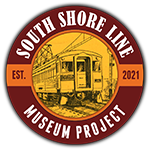South Shore Line Museum Project
PLANNING
For many years, the South Shore Line Museum Project (SSLMP) has had formal planning efforts in place, recognizing that to effectively preserve the past an institution must continually plan for the future.
SSLMP understands five primary sets of planning regimes as critical to its ongoing success as a cultural resource management institution.
1) Institutional Development
To be successful over the long term, SSLMP will create a durable institution with sound and responsible governance, professional management, compelling history and heritage to share, and active engagement with its audiences, communities, and colleague institutions.
Those objectives will be met by traditional long-range institutional practices enhanced by evolving technologies and best practices. Internet platforms make it vastly easier for SSLMP to build agility and longer-term perspectives into its governance and administration.
2) Interpretive Planning
Interpretive Planning is the thoughtful and broadly based consideration of the themes and stories that lie at the heart of an institution’s purpose. It does not lay out a particular version of history, but rather outlines a framework of inquiry that invites visitors (through whatever means) to interrogate South Shore Line History and take away the lessons and insights they find useful.
Interpretive planning has been underway for many years. It has suggested a dozen themes or approaches to make South Shore Line history accessible to many audiences, from K-through-post-secondary students to tourists and local residents. Sound interpretive planning is respectful of whatever histories and attitudes people bring to engagement with the South Shore Line Museum, while at the same time being accurate, honest, and comprehensive in its presentations.
The initial SSLMP Interpretive Plan focuses on the early development of the railroad’s predecessor companies, and its operations through the “Insull Era” ending in 1932. Its formal Period of Significance extends from 1903 through 1932. Subsequent interpretive planning will bring the story to the present as the South Shore Line is America’s longest operating, and sole surviving, classic electric interurban railroad.
3) The Collections Plan
SSLMP has a formal Collections Plan in place guiding decisions as to which objects and ephemera to acquire, which to dispose of, and what supports the long-term objectives of the institution. The substantial collection assembled over the last 40 years has been guided by a series of clear and consistent guidelines, based on the Interpretive Plan. Both plans are capacious and flexible, but remain focused on the many roles electric interurban railroads played in the development of the American Midwest, and especially the Chicago, South Shore & South Bend Railroad, and related companies, in their various incarnations.
The Collecting Plan has informed every decision to acquire or dispose of heritage resources for the past 40 years. It outlines how the project will assess future acquisitions and dispositions and provides guidance for opportunities that may arise. As an example, the Collections Plan anticipated the project’s desire to acquire a 1920s steam railroad dining car similar to those leased by the South Shore Line in the late 1920s. In 2021, the project acquired a dining car identical to those used by the South Shore Line.
4) Development Plan
The survival and prosperity of contemporary cultural institutions depends on their ability to find money, in-kind support, and other kinds of resources. SSLMP recognizes the need to establish stable, adequate, ongoing support for its activities.
SSLMP envisions a broad resource base. It will have a membership and admissions income stream in common with almost all traditional railroad heritage institutions. It will offer a variety of related earned income programs, ranging from gift shop and online product sales to revenue programs such as Dinners-In-The-Diner experiences and Pullman Car Bed & Breakfast lodging.
The range and depth of the project’s exhibit and interpretive opportunities will allow it to strongly compete for support from a wide variety of public and private funding sources. As but one example, the South Shore Line was a pioneering electric railroad. It is in a strong and natural position to partner with local utilities and technology suppliers to develop STEM educational programs and exhibits exploring how electricity has shaped modern American life.
SSLMP understands its roles as a public amenity, tourist attraction, and engine of economic development. It anticipates working with local and regional entities to garner public investment, and in turn bring visitors from across Chicagoland and beyond to enjoy its presentations and support its local economy.
This kind of public-private partnership is well-understood throughout the country. It can be a win-win combination and valid investment in regional economic development—especially in a dense market of over 8 million households increasingly eager for domestic tourism opportunities.
5) Additional Planning Opportunities
SSLMP recognizes that formal planning is an ongoing process without artificial end points.
It will embrace a variety of specific planning exercises, such as Educational/Curriculum Planning, planning for railroad operations, special event planning, and restoration/conservation planning.
Professional-grade planning is the continuing process that enables projects like this to move forward and attain short- and long-term objectives. SSLMP made both common sense and visionary planning integral to its existence.
